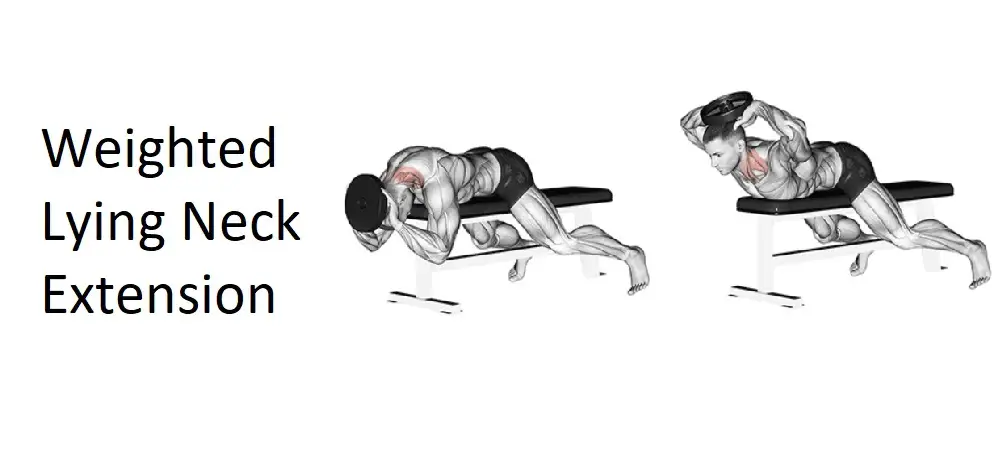Table of Contents
Weighted Lying Neck Extension is a valuable exercise for targeting the muscles of the posterior neck. By performing the exercise while lying down, you can effectively isolate the muscles and provide resistance to enhance strength and muscle development. In this comprehensive guide, we’ll delve into the correct technique, benefits, variations, and other essential details associated with Weighted Lying Neck Extension.
Instructions
Setup:
- Position Yourself: Lie down on a flat bench or exercise mat with your face facing downwards. Ensure that your head is positioned just beyond the edge of the bench, allowing room for movement.
- Secure Weight: Hold a weight plate securely against the back of your head with both hands. Start with a lightweight to ensure proper form and control.
Execution:
- Starting Position: Begin with your head in a neutral position, facing downwards. Your neck should be in a relaxed position, with your chin slightly tucked.
- Neck Extension: Exhale as you slowly lift your head upward, extending your neck against the resistance of the weight plate. Focus on engaging the muscles of the posterior neck throughout the movement.
- Peak Contraction: Once you reach the end of the range of motion, pause briefly to feel the contraction in the muscles of the posterior neck.
- Return to Starting Position: Inhale as you gradually lower your head back to the starting position, maintaining control over the movement. Avoid dropping your head suddenly.
- Repeat: Perform the desired number of repetitions, ensuring smooth and controlled movement throughout.
Benefits
- Targeted Muscle Engagement: Weighted Lying Neck Extension effectively targets the muscles of the posterior neck, including the splenius capitis, splenius cervicis, and semispinalis cervicis muscles.
- Increased Strength and Hypertrophy: By providing resistance against neck extension, this exercise helps strengthen and hypertrophy the muscles of the posterior neck, leading to improved muscle tone and definition.
- Improved Neck Posture: Strengthening the muscles of the posterior neck can help improve neck posture and alignment, reducing the risk of neck pain and discomfort.
- Enhanced Neck Mobility: Weighted Lying Neck Extension helps improve flexibility and mobility in the neck, allowing for better movement patterns in daily activities and exercise routines.
Muscles worked in Weighted Lying Neck Extension
Weighted Lying Neck Extension primarily targets the muscles of the posterior neck, including:
- Splenius Capitis: This muscle runs along the back of the neck and connects the base of the skull to the upper cervical vertebrae. It is involved in extending and rotating the head.
- Splenius Cervicis: Located below the splenius capitis, this muscle also runs along the back of the neck and helps extend and rotate the head.
- Semispinalis Cervicis: This muscle is part of a group of deep muscles that run along the length of the spine. It helps extend and rotate the head and neck.
By performing Weighted Lying Neck Extension, you effectively engage and strengthen these muscles, contributing to improved neck strength, posture, and mobility. It’s essential to maintain proper form and control throughout the exercise to maximize its effectiveness while minimizing the risk of injury. If you experience discomfort or pain during the exercise, cease immediately and seek guidance from a fitness professional or healthcare provider.
Alternate names for Weighted Lying Neck Extension:
- Lying Neck Extension with Weight
- Weighted Neck Retraction
- Supine Neck Extension
- Neck Extension Exercise with Weight
FAQs
What is a weighted lying neck extension?
The weighted lying neck extension is a strength training exercise that targets the muscles at the back of the neck. It involves lying face down on a bench or mat while holding a weight plate against the back of your head and performing neck extension movements against gravity.
Which muscles does this exercise target?
The weighted lying neck extension primarily targets the cervical spine extensors, including muscles such as the splenius capitis, splenius cervicis, and semispinalis capitis.
What equipment is needed for weighted lying neck extension?
You’ll need a weight plate and a flat bench or mat to lie on. Optionally, you can use a towel or cushion to provide comfort and support for your forehead while lying face down.
How do you perform a weighted lying neck extension?
Lie face down on a flat bench or mat, ensuring that your neck and head are fully supported. You can place a towel or cushion under your forehead for comfort.
Hold a weight plate against the back of your head with both hands, using an overhand grip. Your arms should be fully extended.
Slowly lower your head towards the floor, allowing your neck to extend while maintaining control of the weight plate.
Once you reach a comfortable range of motion or when your chin is close to the bench/mat, reverse the movement and lift your head back up to the starting position. Keep your movements controlled throughout the exercise.
Repeat for the desired number of repetitions.
What are some tips for proper form?
Keep your movements slow and controlled to maximize muscle engagement and minimize the risk of injury.
Avoid using momentum to lift the weight plate. Focus on using the muscles in the back of your neck to perform the movement.
Engage your core muscles to stabilize your spine and prevent excessive arching of your lower back.
Use a weight that allows you to maintain proper form while still providing a challenge for the target muscles.
How many sets and repetitions should I do?
The number of sets and repetitions can vary depending on your fitness level, goals, and overall workout routine. A typical starting point might be 2-3 sets of 10-15 repetitions.
Is it safe to perform weighted lying neck extensions?
When performed with proper form and an appropriate weight, weighted lying neck extensions can be safe and effective. However, it’s essential to start gradually, listen to your body, and avoid any movements that cause pain or discomfort.
If you have any pre-existing neck conditions or injuries, it’s advisable to consult with a healthcare professional before attempting this exercise.
Can this exercise help with neck pain or posture?
Strengthening the muscles of the neck, as targeted by the weighted lying neck extension exercise, can potentially help improve neck pain and posture. However, individual results may vary, and it’s essential to address any underlying issues with the guidance of a healthcare professional.
Are there any alternatives to weighted lying neck extensions?
Yes, there are alternative exercises that target similar muscle groups, such as resistance band neck extensions, or using machines specifically designed for neck strengthening.
Should I feel any discomfort during this exercise?
You may feel some muscular fatigue or discomfort, particularly in the muscles being worked, but you should not experience sharp or shooting pain. If you do, stop the exercise immediately and reassess your form and weight/resistance level. If pain persists, consult with a healthcare professional.
Variations
- Unweighted Lying Neck Extension: Perform the exercise without the use of a weight plate to focus on bodyweight resistance.
- Single-Arm Lying Neck Extension: Perform the exercise with one arm at a time to address any muscular imbalances and promote unilateral strength development.
Conclusion
Incorporating a Weighted Lying Neck Extension into your workout routine can be an effective way to strengthen and develop the muscles of the posterior neck. By following the proper technique and gradually increasing resistance, you can experience improved neck strength, posture, and mobility. Remember to start with lighter weights and progress gradually to avoid injury. If you experience any discomfort during the exercise, stop immediately and consult with a fitness professional or healthcare provider.
Also, check the Lever Neck Extension Plate Loaded








